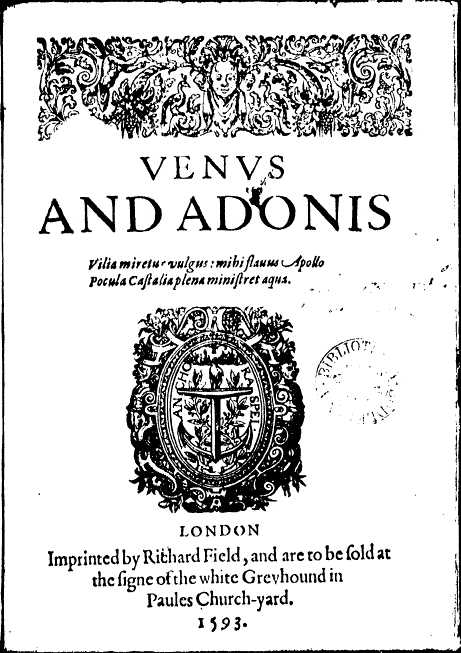Venus and Adonis (Shakespeare poem)
Venus and Adonis is a narrative poem by William Shakespeare published in 1593. It is probably Shakespeare's first publication.
The poem tells the story of Venus, who is the goddess of Love, of her unrequited love, and of her attempted seduction of Adonis, an extremely handsome young man, who would rather go hunting. The poem is pastoral, and at times erotic, comic, and tragic. It contains discourses on the nature of love, and brilliantly described observations of nature.
It is written in a verse form known as sesta rima, which is a quatrain followed by a couplet (ABABCC). This form was also used by Edmund Spenser and Thomas Lodge. The poem consists of 199 stanzas or 1,194 lines of iambic pentameter.
It was published originally as a quarto pamphlet and published with great care. It was probably printed using Shakespeare's fair copy. The printer was Richard Field, who, like Shakespeare, was from Stratford. Venus and Adonis appeared in print before any of Shakespeare's plays were published, but not before some of his plays had been acted on stage. It has certain qualities in common with the plays A Midsummer Night's Dream, Romeo and Juliet, and Love's Labour's Lost. It was written when the London theatres were closed for a time due to the plague.
The poem begins with a brief dedication to Shakespeare's patron, Henry Wriothesley, 3rd Earl of Southampton, in which the poet describes the poem as "the first heir of my invention".
The poem is inspired by and based on stories found in the Metamorphoses, a narrative poem by the Latin poet, Ovid (43 BC – AD 17/18). Ovid's much briefer version of the tale occurs in book ten of his Metamorphoses. Other stories in Ovid's work are, to a lesser degree, considered sources: the tales of Salmacis and Hermaphroditus, Narcissus, and Pygmalion.
It was published about five years before Christopher Marlowe’s posthumously published Hero and Leander, which is also a narrative love poem based on a story from Ovid.
Venus and Adonis was extremely popular as soon as it was published, and it was reprinted fifteen times before 1640. It is unusual that so few of the original quartos have survived.







0 comments
Sign in or create a free account